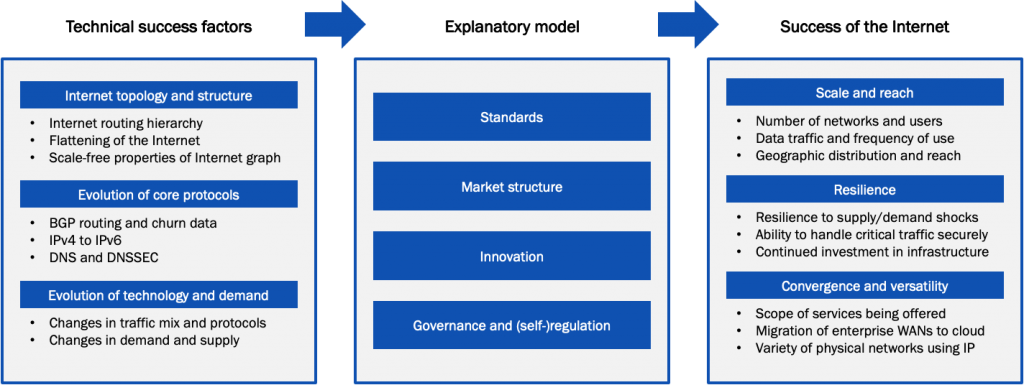
The success of the Internet has been built on protocols, standards and operational practices that have collectively evolved over the past 50 years. Throughout this period questions have been raised about the viability of the Internet, yet it continues to grow, evolve, and succeed in supporting a wide range of increasingly important applications and services.
APNIC and LACNIC have just commissioned a study to understand the technical success factors that underpin the remarkable growth and success of the Internet. We are thrilled that they chose Analysys Mason as a partner in this endeavour.
To approach this study, we will first describe, quantitatively wherever possible, the scope and scale of the Internet. We will then identify technical factors that correlate to this continued success, as highlighted in the figure below. Based on this analysis, we will be able to provide an outlook for the future of these factors and, therefore, the Internet itself. We run through each part of this approach briefly.

The success of the Internet can be measured by the growth in access, usage and applications within and across regions around the world. The adoption and usage have been fuelled by innovation and investment in new networks, which have enabled a change in the content and services with higher bandwidth and lower latency. This evolution demonstrates the success of the Internet in key areas: scalability and reach; flexibility across networks; convergence of services; adaptability to new applications; and resilience.
The technical success factors span all network layers, and can be traced directly to the standards and governance models in place:
- Physical and transmission layers: Capacity has increased, in core and access networks, based on innovation in equipment and significant investments
- IP layer: While IPv6 adoption has been slow, it demonstrates the success and flexibility of IPv4, while BGP has adapted to the growth
- Transport layer: Like IPv4, TCP has been successful from the beginning, while UDP helps real-time communications, and BBR and QUIC are emerging variants
- Application layer: The development of the World Wide Web, for instance, embodied the benefits of ‘permissionless innovation’, along with less conspicuous innovations such as HTML5, WebRTC, OAUTH and many more; while many new services have disrupted traditional ones
The explanatory model brings these together. It will link technical factors and outcomes, enabling inferences on how the technical features of the Internet continue to support its growth and success. As an example, below we show how the increased penetration of the Internet has been matched by the increased assignments of ASNs.

The Internet could hardly be described as successful without considering the reality of its commercial success; in terms of economies of scale that have supported growth, the openness that has supported innovations, and the low barriers to entry that historically have supported diversity and competition.
Finally, we will identify challenges to the continued success of the Internet, whether based on technical limitations, or commercial, market or economic factors. We will frame these to explain success stories and discuss where emerging protocols and standards are addressing these challenges, and where there are gaps.
We welcome all inputs to our study, in the comments here or elsewhere, and look forward to working with APNIC and LACNIC and the broader Internet community on these key issues.
Michael Kende is a Senior Adviser with Analysys Mason, assisting with Internet-related initiatives and advises clients across the globe on Internet policy and strategy.
Amund Kvalbein and David Abecassis contributed to this post.
The views expressed by the authors of this blog are their own and do not necessarily reflect the views of APNIC. Please note a Code of Conduct applies to this blog.
